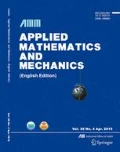Abstract
The idea of using velocity dilation for shock capturing is revisited in this paper, combined with the discontinuous Galerkin method. The value of artificial viscosity is determined using direct dilation instead of its higher order derivatives to reduce cost and degree of difficulty in computing derivatives. Alternative methods for estimating the element size of large aspect ratio and smooth artificial viscosity are proposed to further improve robustness and accuracy of the model. Several benchmark tests are conducted, ranging from subsonic to hypersonic flows involving strong shocks. Instead of adjusting empirical parameters to achieve optimum results for each case, all tests use a constant parameter for the model with reasonable success, indicating excellent robustness of the method. The model is only limited to third-order accuracy for smooth flows. This limitation may be relaxed by using a switch or a wall function. Overall, the model is a good candidate for compressible flows with potentials of further improvement.
Similar content being viewed by others
References
Adams, N. A. and Shariff, K. A high-resolution hybrid compact-ENO scheme for shock-turbulence interaction problems. Journal of Computational Physics, 127, 27–51 (1996)
Pirozzoli, S. Conservative hybrid compact-WENO schemes for shock-turbulence interaction. Journal of Computational Physics, 178, 81–117 (2002)
Ren, Y., Liu, M., and Zhang, H. A characteristic-wise hybrid compact-WENO scheme for solving hyperbolic conservation laws. Journal of Computational Physics, 192, 365–386 (2003)
Hill, D. J. and Pullin, D. I. Hybrid tuned center-difference-WENO method for large-eddy simulation in the presence of strong shocks. Journal of Computational Physics, 194, 435–450 (2004)
Titarev, V. A. and Toro, E. F. Finite-volume WENO schemes for three-dimensional conservation laws. Journal of Computational Physics, 201, 238–260 (2004)
Wang, Q., Ren, X. Y., and Pan, J. H. Compact high order finite volume method on unstructured grids III: variational reconstruction. Journal of Computational Physics, 337, 1–26 (2017)
Hesthaven, J. and Warburton, T. Nodal Discontinuous Galerkin Methods: Algorithms, Analysis and Applications, Springer, New York (2008)
Wang, Z. J., Liu, Y., May, G., and Jameson, A. Spectral difference method for unstructured grids II: extension to the Euler equations. Journal of Scientific Computing, 32, 45–71 (2007)
Wang, Z. J., Zhang, L. P., and Liu, Y. Spectral (finite) volume method for conservation laws on unstructured grids IV: extension to two-dimensional systems. Journal of Computational Physics, 194, 716–741 (2004)
Huynh, H. T. A flux reconstruction approach to high-order schemes including discontinuous Galerkin methods. 18th AIAA Computational Fluid Dynamics Conference, AIAA, 2007–4079 (2007)
Cockburn, B. and Shu, C. W. The Runge-Kutta discontinuous Galerkin method for conservation laws V: multidimensional systems. Journal of Computational Physics, 141, 199–224 (1998)
Burbeau, A., Sagaut, P., and Bruneau, C. H. A problem-independent limiter for high order RungeKutta discontinuous Galerkin methods. Journal of Computational Physics, 169, 111–150 (2001)
Krivodonova, L. Limiters for high order discontinuous Galerkin methods. Journal of Computational Physics, 226, 879–896 (2007)
Zhu, J., Qiu, J., Shu, C. W., and Dumbser, M. Runge-Kutta discontinuous Galerkin method using WENO limiters II: unstructured meshes. Journal of Computational Physics, 227, 4330–4353 (2008)
Qiu, J. X. and Shu, C. W. Hermite WENO schemes and their application as limiters for Runge-Kutta discontinuous Galerkin method II: two dimensional case. Computers & Fluids, 34, 642–663 (2005)
Luo, H., Baum, J. D., and Lohner, R. A Hermite WENO-based limiter for discontinuous Galerkin method on unstructured grids. Journal of Computational Physics, 225, 686–713 (2007)
Persson, P. O. and Peraire, J. Sub-cell shock capturing for discontinuous Galerkin methods. 44th AIAA Aerospace Sciences Meeting and Exhibit, AIAA, 2006–112 (2006)
Klockner, A., Warburton, T., and Hesthaven, J. S. Viscous shockcapturing in a time-explicit discontinuous Galerkin method. Mathematical Modelling of Natural Phenomena, 6, 57–83 (2011)
Moro, D., Nguyen, N., and Peraire, J. Dilation-based shock capturing for high-order methods. International Journal for Numerical Methods in Fluids, 82, 398–416 (2016)
Cook, A. W. and Cabot, W. H. Hyperviscosity for shock-turbulence interactions. Journal of Computational Physics, 203, 379–385 (2005)
Fiorina, B. and Lele, S. K. An artificial nonlinear diffusivity method for supersonic reacting flows with shocks. Journal of Computational Physics, 222, 246–264 (2007)
Kawai, S. and Lele, S. K. Localized artificial diffusivity scheme for discontinuity capturing on curvilinear meshes. Journal of Computational Physics, 227, 9498–9526 (2008)
Mani, A., Larsson, J., and Moin, P. Suitability of artificial bulk viscosity for large eddy simulation of turbulent flows with shocks. Journal of Computational Physics, 228, 7368–7374 (2009)
Premasuthan, S., Liang, C., and Jameson, A. Computations of flows with shocks using spectral difference scheme with artificial viscosity. 48th AIAA Aerospace Sciences Meeting Including the New Horizons Forum and Aerospace Exposition, AIAA, 2010-1449 (2010)
Cantwell, C. D., Moxey, D., and Comerford, A. Nektar++: an open-source spectral/hp element framework. Computer Physics Communications, 192, 205–219 (2015)
Barter, G. E. and Darmofal, D. L. Shock capturing with PDE-based artificial viscosity for DGFEM: part I, formulation. Journal of Computational Physics, 229, 1810–1827 (2010)
Karniadakis, G. E. and Sherwin, S. Spectral/hp Element Methods for Computational Fluid Dynamics, Oxford University Press, Oxford (2005)
Kawai, S., Shankar, S., and Lele, S. Assessment of localized artificial diffusivity scheme for largeeddy simulation of compressible turbulent flows. Journal of Computational Physics, 229, 1739–1762 (2010)
Author information
Authors and Affiliations
Corresponding author
Additional information
Citation: Yu, J., Yan, C., and Jiang, Z. H. Revisit of dilation-based shock capturing for discontinuous Galerkin methods. Applied Mathematics and Mechanics (English Edition), 39(3), 379–394 (2018) https://doi.org/10.1007/s10483-018-2302-7
Rights and permissions
About this article
Cite this article
Yu, J., Yan, C. & Jiang, Z. Revisit of dilation-based shock capturing for discontinuous Galerkin methods. Appl. Math. Mech.-Engl. Ed. 39, 379–394 (2018). https://doi.org/10.1007/s10483-018-2302-7
Received:
Revised:
Published:
Issue Date:
DOI: https://doi.org/10.1007/s10483-018-2302-7




